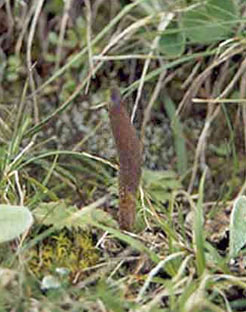
CORDYCEPS
(Cordyceps sinensis)
Cordyceps is a unique type of mushroom. Whereas many medicinal mushrooms (e.g., ganoderma, shiitake, coriolus, tremella), grow on live or decaying portions of trees, this one grows on caterpillar bodies that have died and fallen to the ground. During the summer, a mushroom blade, looking a bit like a blade of grass, emerges among ordinary grasses and weeds. Thus, the herb is known in Chinese as "winter caterpillar, summer weed" (dongchong xiacao) or simply caterpillar grass (congcao). Once the cordyceps blade is fully grown (reaching up to 3 inches high), the caterpillar remains in appearance only: the chitin of the outer form is still there, but the inside is replaced by the mycelium (mushroom fiber).
Cordyceps has long been revered as a tonic for people suffering from weakness for various reasons, including prolonged illness, overwork, and aging. It is considered a sexual tonic and a therapy for weakness of the lungs leading to frequent bronchitis or to asthma. Recent applications include improving sports performance, adjusting to high altitude, lowering blood lipids, and promoting immune functions.
This fungus is rare and hard to find. It mainly grows in the mountainous regions of Western China (e.g., Qinghai, Sichuan, Guizhou, Yunan) and through the Himalayan range, being collected mainly in Tibet and Nepal. Cultivators raise caterpillars in quantity which are then inoculated with the fungus and left to grow as they would in nature. Today, with demand for cordyceps being so high, much of the cordyceps used medicinally is grown in batch cultures in commercial quantities; either the mycelium from the cultures, an extract of the mycelium, or the culture liquid after growing the mycelium is used.
In Tibet, the natural cordyceps (called Yartsa Gunghu) is still cultivated and collected from the wild. It is used in soups and decoctions, ground to powder for use in capsules and tablets, and added to green tea to make a healthful beverage. Collecting the wild mushroom has become an important source of income for rural Tibetans. A family working during the summer growing season is able to collect 1-4 kilograms of cordyceps, enough to cover their expenses for up to a year. However, the competition for the mushroom has grown intense, and it is difficult for one family to get access to more than 2 kg in a year.